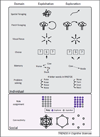Exploration versus exploitation in space, mind, and society
- PMID: 25487706
- PMCID: PMC4410143
- DOI: 10.1016/j.tics.2014.10.004
Exploration versus exploitation in space, mind, and society
Abstract
Search is a ubiquitous property of life. Although diverse domains have worked on search problems largely in isolation, recent trends across disciplines indicate that the formal properties of these problems share similar structures and, often, similar solutions. Moreover, internal search (e.g., memory search) shows similar characteristics to external search (e.g., spatial foraging), including shared neural mechanisms consistent with a common evolutionary origin across species. Search problems and their solutions also scale from individuals to societies, underlying and constraining problem solving, memory, information search, and scientific and cultural innovation. In summary, search represents a core feature of cognition, with a vast influence on its evolution and processes across contexts and requiring input from multiple domains to understand its implications and scope.
Copyright © 2014 Elsevier Ltd. All rights reserved.
Figures




References
-
- March JG. Exploration and exploitation in organizational learning. Organ. Sci. 1991;2:71–87.
-
- Treisman AM, Gelade G. A feature-integration theory of attention. Cogn. Psychol. 1980;12:97–136. - PubMed
-
- Wolfe JM, et al. Guided search: an alternative to the feature integration model for visual search. J. Exp. Psychol. Hum. Percept. Perform. 1989;15:419–433. - PubMed
-
- Benhamou S. How many animals really do the Lévy walk? Ecology. 2007;88:1962–1969. - PubMed
Publication types
MeSH terms
Grants and funding
LinkOut - more resources
Full Text Sources
Other Literature Sources

